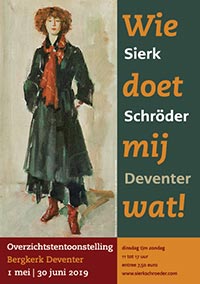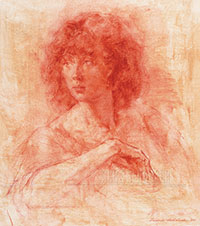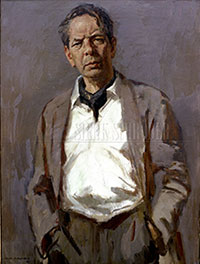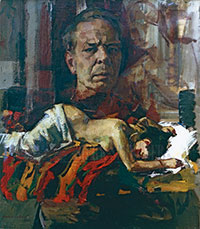| The Sierk Schröder Foundation owns the copyright to all works of art of Sierk Schröder |
 |
| Home | Gallery | Portraits | Biograhpy | Foundation | Exhibitions | News | Webshop | Counterfeits | Press reports | Reviews |
|
Home | Biography | Biographical data Sierk Schröder Comprehensive biography Sierk Schröder Sierk Schröder (1903-2002)Biographical data1903-1919 The family move to Utrecht in 1915 where Sierk visits the grammar-school. He comes more and more under the spell of drawing. From 1919 to 1922 Sierk follows the Colonial Agricultural School in Deventer. But the idea of becoming a planter fades. On the contrary, drawing and painting become increasingly important. In an attic he even creates himself a studio and soon the first order for a portrait follows, in exchange for a box of cigars. In 1922 Sierk attends the Hague Academy of Visual Arts where he is directly admitted to the third year's course (out of five years), owing to his exceptional talent. A whole new world opens up for him. Besides the drawing lessons to plaster models only, Sierk seizes the opportunity to take separate lessons in model drawing (upon living models). These lessons are given in the evenings by Henk Meyer, an extraordinarily clever draughtsman, very critical, hard, but unimpeachable, as Sierk describes him. Sierk regards him as his ideal teacher for model drawing. In 1925 he graduates. 1925-1926 In Paris Sierk becomes friends with the painters Frits Klein and Jos Croin. With Matthieu Wiegman among others Sierk draws model in the Academie de la Grande Chaumiere in the evenings. In the Rotonde he looks at work by Foujita, van Dongen and others. But he also sees the first exhibition of the avant-garde, the ultra moderns: paintings of torn newspaper and barbed wire with Dadaïst slogans. Sierk is not impressed. But he is impressed in the Louvre, where he often studies the old masters. For him it's a settled matter then, that he will accomplish what the old masters were able to. Bitter poverty (his father was lacking in money to support him) occasionally forces Sierk to earn by illustrating. Which he does for Publisher Callenbach, as he already did during the last year at the Academy. Sierk returns from Paris in the spring of 1926, weakened and severely malnourished. His father had passed away in the Dutch East Indies and the Military Service is to be fulfilled. However, he enters the Military Hospital where Sierk, suffering from pleurisy, is being nursed. After recovery and his dismissal from the Service he leaves for Switzerland to convalesce. He also makes a short study trip to Florence. 1926-1929 are the years of the Royal Grant. In the early 30ies Sierk becomes member of De Haagsche Kunstkring (Hague Art Circle). Contacts and friendships arise with, among others, Ben Eysselsteijn, Eduard Veterman, Chris de Moor and Willem van Konijnenburg. In 1932 Sierk gets his first exhibition at the renowned art dealer d'Audretsch, The Hague (Circuit around Bremmer - H.P. Bremmer, an influential art critic). Praised reviews appear in the press (including the NRC, Algemeen Handelsblad) from Hammacher and Elias. They also appear in 1936 when Sierk again exhibits at d'Audretsch. More portrait commissions follow and there is a lot of illustration work for him to do. 1934-1939 In 1935 Sierk is awarded the Thérèse van Duijl-Schwartze-Prize. 1940-1944 By the end of the war Sierk joins the 'Paauwhof', then a centre of artists, writers and musicians such as Anthony Donker, Jacques Bloem and Sem Dresden (composer). Sierk becomes friends with several painters who belong to the group such as Ru de Bruyn Ouboter, Ina Hooft and in particular with Frederic Reitman, whom he studied with at the Academy. About Reitman Sierk writes: he was a very clever figure draughtsman. I learned a lot from him. Furthermore Sierk writes: More and more I became convinced of the value of 'alla prima painting'. Hals, van Dyck, Rubens, all 'fast painters', clearly to be seen in the brushstroke. I had to break away from the general applicable academic method of first creating a drawing to be transferred (by 'punching') onto canvas, then thinly paint it over and carefully fill in to depict eventually. A method based on fear of not being able, on correcting errors rather than doing it right straight away. But to do it right the first time, one should also be able to draw well: 'to draw or not to draw'. This method I have been able to support in the own copies and later in works of Velasquez in the Prado. It remained a controversial question, especially with my colleague Röling when I taught portrait and figure painting in Amsterdam later on. 1945-1947 Sierk, however, feels the strong pressure of being overwhelmed with portrait commissions, leaving him no time to work freely. It is therefore a relief for him when his good friend Jacques Schreuder comes up with a solution. He enables Sierk to work entirely freely during three months per year for three years in succession. Schreuder finances the periods of free painting with a fixed amount per month. In return, he may choose some works created by Sierk during these periods. Sierk starts traveling again. He writes: in those years the main event was a trip to Paris, where I saw an exhibition of the Impressionists in the Orangerie. Overwhelming impression as far as colour concerns. Back again I saw my own work in a small exhibition I had in Amsterdam. I saw how muddy and dirty my colours were and I was frightened. A reversal in 'seeing'. Then I switched to pastel in order to achieve better use of colour. In pastel one must 'choose', one cannot 'mix'. To make dark shadows by rubbing through a dark colour, is not possible. The dark must be obtained by colour, by putting colour side by side, one must learn to see shape in colour. 1949-1951 In 1950 Sierk starts working in the studio of Lucien Fontana Rosa for about six weeks. This painter belonged more or less to the group of 'Le réalisme poétique' (Poetic Realism) with painters such as Brianchon and Oudet. Sierk writes about them: I was very impressed by both painters. In the Boijmans Museum (Boijmans van Beuningen) hangs a beautiful woman portrait of Brianchon. Undeniably, the work of this group, including that of Fontana Rosa, has had a great influence on my work at that time. In 1950 Sierk receives the Jacob Maris Material Prize and in 1952 the Jacob Hartog Prize with a portrait of the art critic Cornelis Veth. In 1953 Sierk travels to Spain: Prado Museum, Velasquez, Madrid, Goya. In Toledo he makes many drawings. After 1953 exhibitions follow very regularly among others in the large halls of the Painter's Society 'Pulchri Studio', opened by Dr. Nico Vroom (1953), in the Arnhem Municipal Museum (1954), in Museum 'De Lakenhal', Leiden (1959), in The Hague Municipal Museum, first with drawings (1957) and later with oil portraits (December 1963/January 1964), Singer Museum in Laren (1960), in Hoensbroek Castle (1964), opened by Mr. Drs. L.J.F. Wijsenbeek (Director of The Hague Municipal Museum), a series of exhibitions in Paris, the first exhibition at 'Galerie Arts Sélection' (1965) was opened by Frits Lugt (Président of the 'l'Institut Néerlandais' de Paris). 1960-1968 After more than 25 years of working in his studio, located in the woods
around the Johanna House, Wassenaar, he moves to a studio in The Hague
in 1968, situated on the corner Buitenhof-Passage, above the historically
famous café 'Riche'. This studio with interesting spaces and
a good incidence of light inspires him to make a lot of work in which
the human figure dominates. Making free work continues despite the many
portrait commissions that just keep coming. In 1971, together with Paul Citroen, Sierk exhibits in the Rheinische LandesMuseum Bonn, from where the exhibition moves to 'der Schanze' in Münster. From 1973 Sierk works in his spacious and bright studio in the Korte Houtstraat, The Hague. He accepts fewer commissions and continues to make more and more free work. He also makes several work trips and various holidays e.g. to Crete (2x), Vaison La Romaine, Provence (3x), Majorca and Corfu. During these travels many landscape and nature studies arise, mostly in watercolour. At the age of 84 (1987) Sierk gives up his studio in the Korte Houtstraat, The Hague. Meanwhile, as a result of an extensive rebuilding, a spacious studio becomes available in his country house in Wassenaar where he devotes himself to nature studies: plants, animals, flowers and fruits. However, the model still remains important to him. When Sierk looks back, (as he notes) he considers the time after his professorship, so after 1968, as the most fertile period of his artistic career. He feels less bound to accept portrait commissions, thus leaving more time available for making free work. Sierk experiences the continuous growing interest in his work. There are many exhibitions and his free work is highly sought after and sold out during sales exhibitions within the shortest time. Collections arise. The work takes on a life of its own (a strange experience!) is a note that Sierk makes. In 1986 the NOS-TV broadcasts the documentary 'Sierk Schröder painter draughtsman', with an interview by Dr. Antoine Bodar. In 1988 Sierk receives the Jacob Hartog Oeuvre Prize and the
Culture Prize of the Municipality Wassenaar. From the eighties on Sierk experiences a steady revaluation of the traditions in visual arts. Young promising painters approach him for advice for which he is open, despite his advanced age. His retrospective exhibition in the large halls of Slot Zeist, December
1992, January 1993, opened by Professor J.N. van Wessem, attracts tens
of thousands of visitors. Earlier retrospective exhibitons were held in the halls of the Painters' Society Pulchri Studio, The Hague (1978, 1983 and 1988), 'Park Plaza', Amsterdam, in the Municipal Museum Maassluis (1986), in Museum 'Tongerlohuys' Roosendaal (1990), in the historical building of the 'Faculty Club', organized by the Catholic University of Leuven, Belgium (1989) and in the Palace 'Raadhuis de Paauw ' in Wassenaar (1990). A major retrospective exhibition is held in the year 2000 in the halls of the painters' society 'Pulchri Studio', The Hague, introduced by Theo Laurentius and opened by Drs. P.H. Schoute, Mayor of Wassenaar, in the presence of Her Majesty Queen Beatrix. His ninetieth birthday had already passed, Sierk makes many self-portraits
in charcoal and chalk, sometimes with a touch of humour as Sierk like
an 'Old Master' or Bellini. During the night of July 27 and 28, 2000, burglars succeed in stealing several works of art from Sierk Schröder's home, including the baby portrait in oil of daughter Ruth with the eyes closed and some intimate pencil drawings, which Sierk made of his dear mother on her death-bed. On January 26, 2002, after a short illness, Sierk Schröder dies in his country house in Wassenaar, almost 99 years old. Soon after his death the Utrecht University releases a press report
announcing that as a homage to Sierk Schröder the
portraits of Professors, painted by him, will be permanently shown shown
in the Academy Building, in the 'Sierk Schröder Room' as it was
named after him. For biographical data : click
here |
|
|
Rapenburg 98, NL-2311 GA Leiden – Tel. 0031 (0)71
3645469
© Copyright: Sierk Schröder Foundation. All Rights Reserved The Sierk Schröder Foundation owns the copyright to all works of art of Sierk Schröder - Contact |



